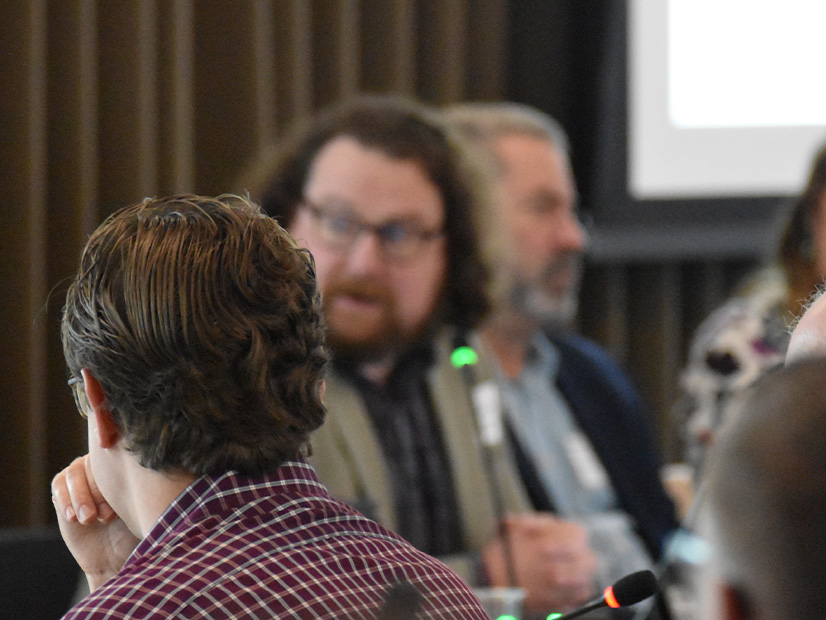PORTLAND, Ore. — It’s taken CAISO’s Western Energy Imbalance Market (WEIM) nearly nine years to expand to cover about 80% of the load in the Western Interconnection since being launched with PacifiCorp as its first participant.
But after a little more than a year of outreach, SPP is contesting much of that ground as it hustles to attract participants to Markets+, a fast-rising competitor that is drawing strong interest in the West just as CAISO moves to broaden the real-time WEIM into the long-awaited Extended Day-Ahead Market (EDAM).
The near-term issue for the region’s electric industry participants is which day-ahead market to choose, but their decisions likely will set the course for the eventual development of a Western RTO — or multiple RTOs.
“Once we move to a day-ahead market, that is a much larger footprint [of energy transactions]. It is much harder to transition from one day-ahead market to a separate [market] to get to an RTO/ISO,” Alex Swerzbin, director of transmission and markets for PNGC Power, a Portland-based generation and transmission cooperative, said during a July 14 meeting to kick off the Bonneville Power Administration’s (BPA) effort to choose a day-ahead market.
The deep interest in Markets+ was evident at a packed June meeting SPP hosted at BPA’s Portland headquarters.
Attending the two-day event were about 60 people representing utilities and other organizations from across the West, including Arizona Public Service, Black Hills Energy, BPA, Portland General Electric (PGE), Puget Sound Energy, Salt River Project, Tacoma Power, The Energy Authority, Renewable Northwest and Northwest Energy Coalition (NWEC), among others.
Notably absent was PacifiCorp, which already has committed to CAISO’s EDAM. The Portland-based utility controls more than 17,000 miles of transmission and 11,500 MW of generation in six states.
SPP officials running the meeting quickly got deep into the weeds, with the first day consisting of exhaustive lessons on organized market concepts (such as reliability unit commitment, co-optimization, settlements and virtual transactions), peppered by back-and-forth among participants about what they would seek in the early stages of a rollout. An outside observer could be excused for assuming Markets+ already was a going concern.
“I sent some information to CAISO saying, ‘Hey, you know, they’re so interested in this stuff that they’re considering virtuals as a starting proposition,’” Scott Miller, executive director of the Western Power Trading Forum, told RTO Insider in an interview shortly after the meetings.
“I think it has a lot of momentum,” said one meeting participant, who is not authorized to speak on behalf of their employer, a Western utility. “They may not beat WEIM to a day-ahead market, but they have more momentum for a Western RTO.”
“I think if there was one word to describe the Markets+ zeitgeist, it’s ‘momentum,’” Miller agreed.
“SPP is making a lot of progress,” he said. “Its stakeholder process has so charmed people that it’s added to that momentum.”
Not all attendees were caught up in the zeitgeist.
“I can’t see how we can have two markets in the West, particularly with PacifiCorp going with EDAM — and possibly PGE,” one attendee said on the sidelines. That attendee also pointed out that California is by far the region’s biggest player and that two competing markets would put “a big seam” in the West.
But as Miller pointed out, governance continues to be a stumbling block for CAISO’s effort to expand into a Western RTO. Under California law, the ISO’s governing board must be appointed by the state’s governor, an unacceptable political arrangement for other Western states that bristle at prospect of yielding control of their grids to the biggest state in the nation.
California lawmakers have three times failed to pass bills authorizing an independent board, and yet another bill to address the issue has stalled in committee during the current session.
The governance problem took on a new sense of urgency last month when BPA launched its day-ahead market stakeholder process, committing to making a decision in the first quarter of next year.
“With EIM, we watched that market develop for several years before we even began our process of evaluating whether to join,” Russ Mantifel, BPA director of market initiatives, said at the July 14 kick-off meeting. “That is very much explicitly and intentionally not what Bonneville is doing here. Our intent here is to try to be proactive, as much as possible, both in the development of these markets, and in terms of making a decision at an earlier point, in order to position ourselves to join a market earlier in the lifecycle of these markets.”
In other words, with 15,000 miles of transmission and nearly 17,500 MW of generating capacity in the Northwest, BPA wants a seat at the head of the table for planning a market that likely will become the foundation for a full RTO. And for statutory reasons, CAISO’s state-run governance is a clear non-starter for the federally operated BPA.
Changing Expectations
But even if California lawmakers do act on governance, Miller said, that no longer may be the pivotal issue for BAs considering a commitment to CAISO. Market participants will seek deeper cultural shift in the ISO, one that would transform its staff-driven policy process into a stakeholder-driven one like those in other multi-state RTOs such as SPP, MISO and PJM.
“Now they’ve been exposed to a stakeholder process that the stakeholders run, and there still hasn’t been a stakeholder process [in CAISO] that is developed much differently, even in the context of the EIM,” Miller said. “So, CAISO hasn’t figured out that everybody’s expectations have changed, because they haven’t had a chance to yet because they’ve been so focused on writing their [EDAM] tariff — understandable — and trying to work with the legislature to see if they can get the governance change.”
But not every Western stakeholder is so charmed by SPP’s stakeholder process. Vijay Satyal, deputy director of Western energy markets at Western Resource Advocates (WRA), a Colorado-based environmental non-profit, thinks that process doesn’t give fair play to perspectives from outside the electric sector.
“They’re taking all the feedback of market participants, but the definition of market participants for SPP is the people who bring generation or load or both — that are utilities or customers,” Satyal said in an interview. “But in the Cal ISO process, anybody can bring any issues to the table and they get addressed, and then we get responses back.”
Satyal pointed out that the WEIM’s Regional Issues Forum (RIF), a stakeholder body he chaired last year, will exercise new authority under EDAM “to deliberate on trending issues before they become stakeholder proposals” in CAISO.
“Can you find me a RIF design in Markets+? There isn’t one conceived yet. That’s an area we want to push,” he said.
Satyal also offered a more generous take on CAISO’s existing governance, pointing out that the WEIM’s Governing Body consists of five members who are not selected by California’s governor but elected by stakeholder sector committees.
“That’s independence. That’s parallel authority. That has truly not yet been appreciated,” he said.
Furthermore, Satyal questioned the independence of the Markets+ Independent Panel (MIP), the body SPP established earlier this year as “the highest level of authority for decisions related to Markets+.” He noted that the five-member MIP includes two SPP board members: Steve Wright, a former BPA administrator, and John Cupparo, previously a senior executive with Berkshire Hathaway Energy and PacifiCorp. MIP decisions are, in turn, still subject to approval by the full SPP board.
Echoing Satyal’s concern was Fred Heutte, a senior policy associate with the Northwest Energy Coalition.
“Are we the only ones who are concerned about the fact that Markets+ has a process going forward where the Markets+ board and the SPP board, neither of which have had any voice whatsoever in their selection from the West, will be actually making the decisions in this initial phase?” Heutte said at BPA’s July 14 meeting. “Are there governance issues on both sides?”
The Matter of Seams
NWEC and WRA share another key concern: the impact of dividing the West into two separate markets that potentially would be cut through by a tangle of seams, depending on where various BAs choose to put themselves.
Both organizations have long been advocates for creating a single West-wide RTO that includes California to realize the full potential of sharing renewables across the region, in order to avoid curtailments and ensure a maximum reduction of greenhouse gas emissions. In that scenario, California’s daytime solar surpluses are seen as a complement to a potentially vast buildout of wind energy resources in other parts of the West, as well as the existing hydro resources in the Northwest.
“We want one large market in the West,” Satyal said. “There is tons of evidence that one large market will eliminate extra transaction costs, information management and different business practices where the different definitions exist in two markets.”
WPTF’s Miller said the seams issue could be managed by an enforceable agreement between the two markets.
“FERC would force whatever entities there are to have a joint operating agreement so that you could still sell either day-ahead or energy imbalance into each other’s systems,” he said.
But Heutte is skeptical about such an arrangement.
“The evidence from the East is very strong: that seams agreements are big, complicated things that never reach perfection, require a considerable amount of attention [and] include transaction costs and so forth,” he told BPA officials at their July meeting.
For Satyal, the economic case for a single RTO can be found in the 2021 state-led market study that estimated that the U.S. portion of the Western Interconnection could realize $2 billion in savings a year by 2030 if it adopted one market. The study’s two-market scenarios yielded considerably lower savings for the region as whole. (See Study Shows RTO Could Save West $2B Yearly by 2030.)
But results from a company-specific study, conducted by the Western Markets Exploratory Group (WMEG), paint a more complicated picture, industry sources have told RTO Insider. Those findings, released last month to individual entities, remain confidential, but the sources said they indicate California would be the biggest beneficiary of a single market, while others — but not all —actually could reap greater economic benefits from a two-market solution.
Individual utilities are expected to make those results public at their own discretion, with some required to disclose the data to their regulators before a public release, one source said. Andy Meyer, a public utility specialist with BPA, told attendees at the July 14 meeting that BPA might begin to “trickle out” its own study results starting in September, but he offered no guarantee.
“The state-led market study had a very thorough public review,” Heutte said at the meeting. “Given the nature and potential impact of this decision, we hope that Bonneville will put all your cards on the table, not just the ones that lead one way or the other, whichever way, because it’s really important for us to have a full understanding of what the consequences could be.”
Lifeline for CAISO?
With CAISO stymied on governance, it’s unclear whether the proposal last month by a group of Western utility commissioners to create an independent RTO based on the ISO’s operating framework will gain traction. (See Regulators Propose New Independent Western RTO.)
Under the plan, laid out in a July 14 letter to the chairs of the Western Interstate Energy Board (WIEB) and the Committee on Regional Electric Power Cooperation (CREPC), “a non-profit entity governed by representation from across the West would be formed” to contract for RTO services with CAISO, “including eventual assumption of the Extended Day-Ahead Market (EDAM) and the Energy Imbalance Market (EIM).”
The letter, signed by regulators from Arizona, California, New Mexico, Oregon and Washington, emphasized the transaction cost benefit of avoiding seams. Among the signatories was Washington Utilities and Transportation Commission member Anne Rendahl, who sits on the Markets+ State Committee and formerly chaired the WEIM’s Body of State Regulators. Rendahl declined to comment for this story, saying her commission may be asked to weigh in on the market proposals in future utility proceedings.
The Western utility source who spoke to RTO Insider not for attribution said some industry participants outside California are skeptical that their interests would have equal footing with those of the most populous U.S. state under the arrangement.
That’s a view apparently shared by former WPTF head Gary Ackerman, who in the July 21 edition of his widely distributed Friday Burrito newsletter wrote: “An independent entity with a contractual link to the CAISO will not easily satisfy multi-state governance issues because of the lopsided weight of the CAISO load relative to all the other balancing authorities outside of the CAISO. Sure, it’s worth trying but expectations must be kept in check.”
“The more diversity, the fewer seams you have, the more effective [a market is] going to be — I can’t disagree with that,” BPA’s Mantifel said. “I think … the other reality is what it takes to get there, and sort of the sacrifices and compromises people are willing to make in order to achieve that, and whether that’s ultimately viable.”
SPP will hold meetings of its MIP and Markets+ Participants Executive Committee Aug. 8-9 in Portland. CAISO, along with the Balancing Authority of Northern California, NV Energy, PacifiCorp and Southern California Edison, will host an EDAM forum in Las Vegas on Aug. 30. BPA’s next set of day-ahead market meetings will be held at the agency’s Portland offices Sept. 11-12




